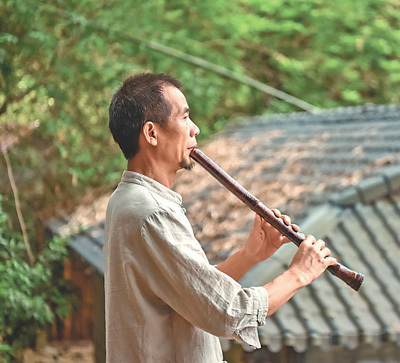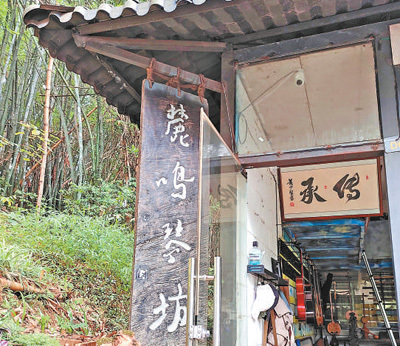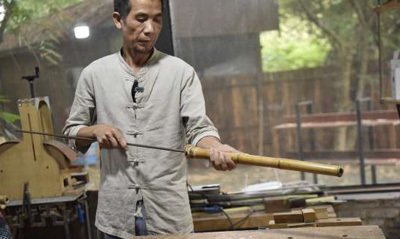Lu Ming, a musician who focuses on the production of traditional folk musical instruments, Shakuhachi

Lu Ming is playing shakuhachi.

Luming Qinfang.

Lu Ming is making shakuhachi.
The "Craftsman's Garden" in the western suburbs of Nanning, Guangxi, covering an area of 1,000 mu, was a barren farm more than ten years ago. Today, many craftsmen live here and devote their efforts to their unique craftsmanship. Lu Ming, who is accompanied by musical instruments all day long, is one of them.
"I am a very simple person. I have only liked music all my life. In the past five or six years, I have been addicted to researching and making shakuhachi. It is wonderful that a simple bamboo pipe can play the sounds of nature," Lu Ming said.
The shakuhachi is named after the tube length is about 1 chi 8 inch of the Tang chi. It was one of the main musical instruments in the court during the Sui and Tang Dynasties in my country. In recent years, shakuhachi has gradually been re-recognized by the Chinese.
"It takes more understanding to make a shakuhachi. It's not good to do it only based on data parameters." Lu Ming said that the traditional shakuhachi has only 5 sound holes, which can express a variety of sounds beautifully. The secret lies in the polishing of the inner cavity of the bamboo tube. The polished inner cavity curve can match the air flow angle, speed and sound hole pressing changes when playing, which can express the battle of thousands of troops and the whispering of summer insects. There are only 5 holes in the shakuhachi, and part of the sound can only be expressed by the angle and strength of the air when playing, which not only tests the player's stable technique level, but also tests the maker's structure and control of the coating curve of the inner wall of the lumen.
Hand-made piano is a test of the luthier's hearing. Lu Ming, who was born as a musician, is particularly sensitive to sound quality and timbre. What ordinary people hear is the smallest difference, in his ears, it is a world of difference. "One octave is good for tuning, but when tuning two or three octaves, it takes days to tune a single note, or even a month." Lu Ming said that the shakuhachi he made are all according to the It is made in accordance with the requirements of the band to play the instrument. If it can't play 3 octaves, it is a waste product.
Lu Ming said that he "wasted" at least 600 or 700 osmanthus bamboos. He didn't pay attention to them in the past few years, and they randomly piled them in the bamboo forest in the back mountain. Later, he found that they were often picked up by garden visitors and even used to play. "The defective products were all burned. The shakuhachi was originally a niche musical instrument. If these things were spread out, it would easily cause misunderstandings in the music circle, and people would think that the shakuhachi was originally inaccurate." Lu Ming said.
Lu Ming, who wears a cloth coat and cloth shoes all day, is actually full of Western musical instruments before 2016, and has no concept of shakuhachi. Born in 1969 in the forest area of Longsheng Autonomous County, Guangxi, Lu Ming began to tinker with his own guitar when he was a teenager. Later, he worked as a bass player in a well-known band in Guangdong for 20 years. In his spare time, he customized the piano for the band. Guitar.
"Shakuhachi is an excellent national musical instrument in our country. People who make musical instruments must have a sense of mission. We must work hard to 'seek our roots', otherwise we will lose our heritage and direction." Lu Ming said that the excellent traditional Chinese culture belongs to our nation. Gen and Soul, he has been focusing on the production of shakuhachi in the "Artisan Garden" over the years, just wanting to reproduce the old Huayin.
Lu Ming, who switched to research and production of shakuhachi, lived a poor and simple life.
This stilted building with only more than 50 square meters is built on the mountain, and the walls are all made of transparent glass. At the corner of the wall near the ceiling, he built a 1.2-meter-wide space for himself as a bedroom, which was slightly shielded by cardboard boxes. During the day, the folded ladder of the upper bedroom was placed on the ground as an unfinished musical instrument. shelf. On a flat floor below the stilted building, there is a wooden table in the open air, surrounded by several small stools of different materials and heights.
Lu Ming's shakuhachi is melodious and ethereal, with strong penetrating power, often attracting passers-by to stop and even come to greet him. In the early morning of May 1st, a newly hatched Bulbul was blown down by the strong wind. Now it is a "little fan" of Lu Ming. As long as he hears Lu Ming playing the shakuhachi, it will fly to Lu Ming's shoulder or On the shakuhachi, listen quietly.
"The road is simple, and music must ultimately return to its origin." From being fascinated by Western musical instruments to devoting himself to the research and production of traditional folk musical instruments, shakuhachi, Lu Ming has a deeper understanding of music. Lu Ming said with a smile that he had been thinking about what it was like for the ancients to play shakuhachi thousands of years ago.
 渝公网安备 50010702504639号
渝公网安备 50010702504639号